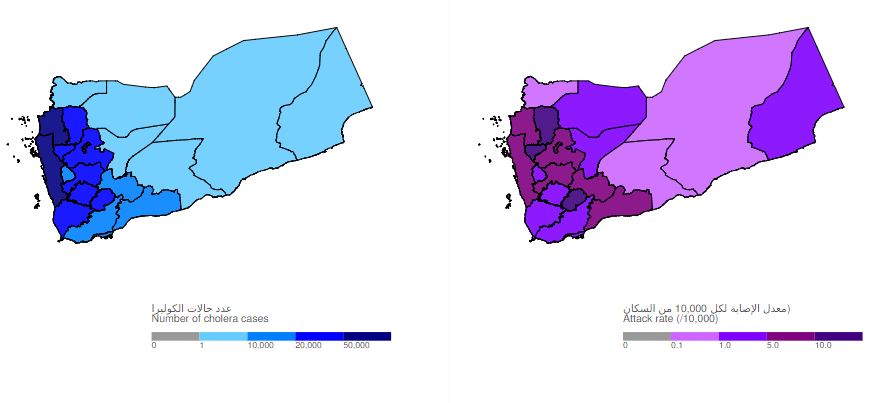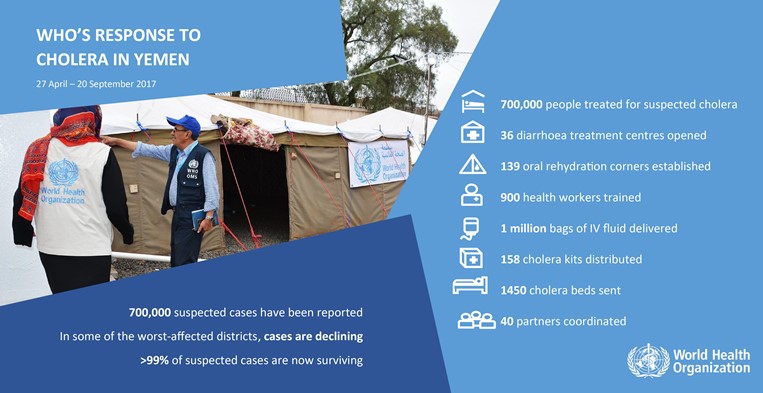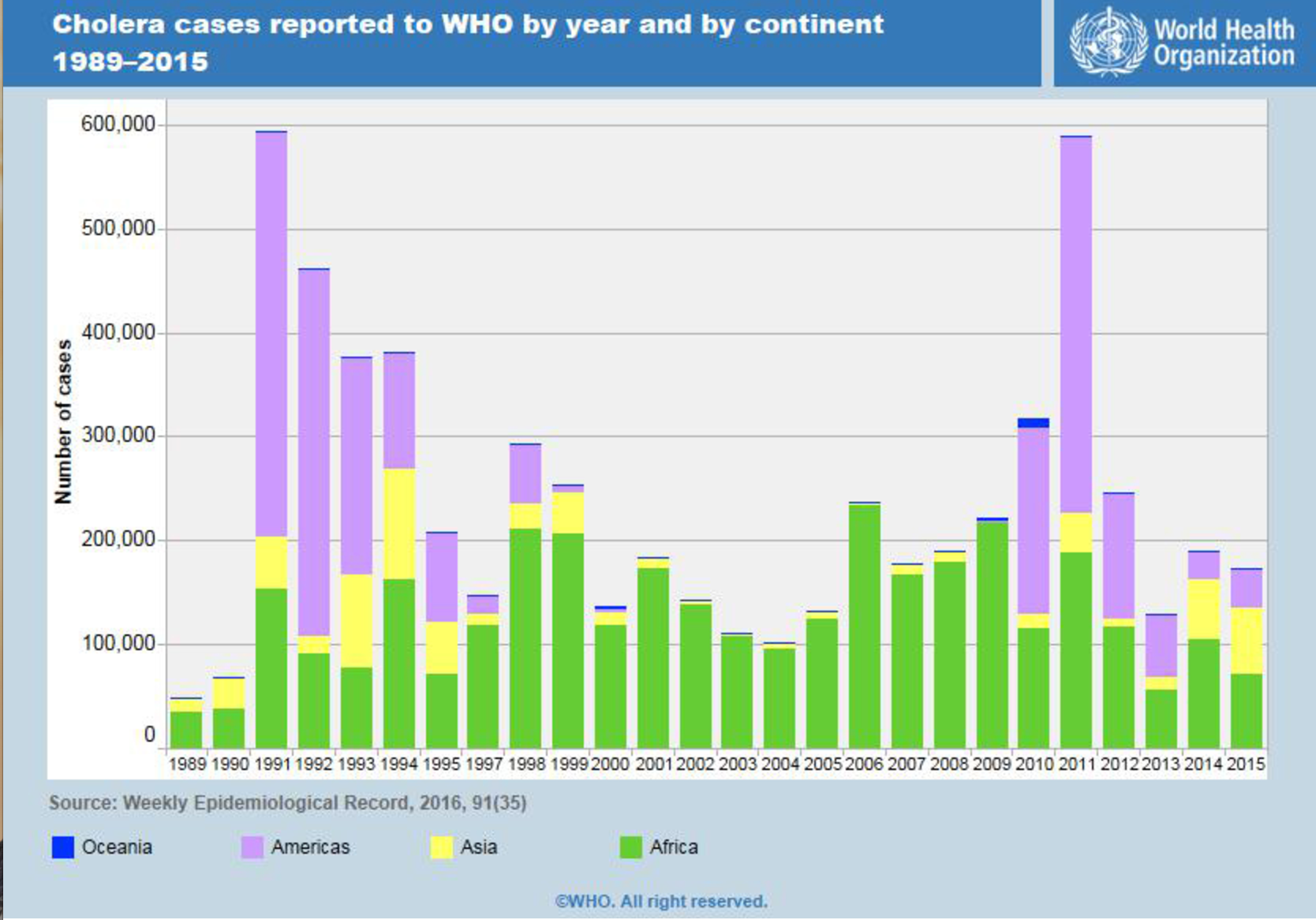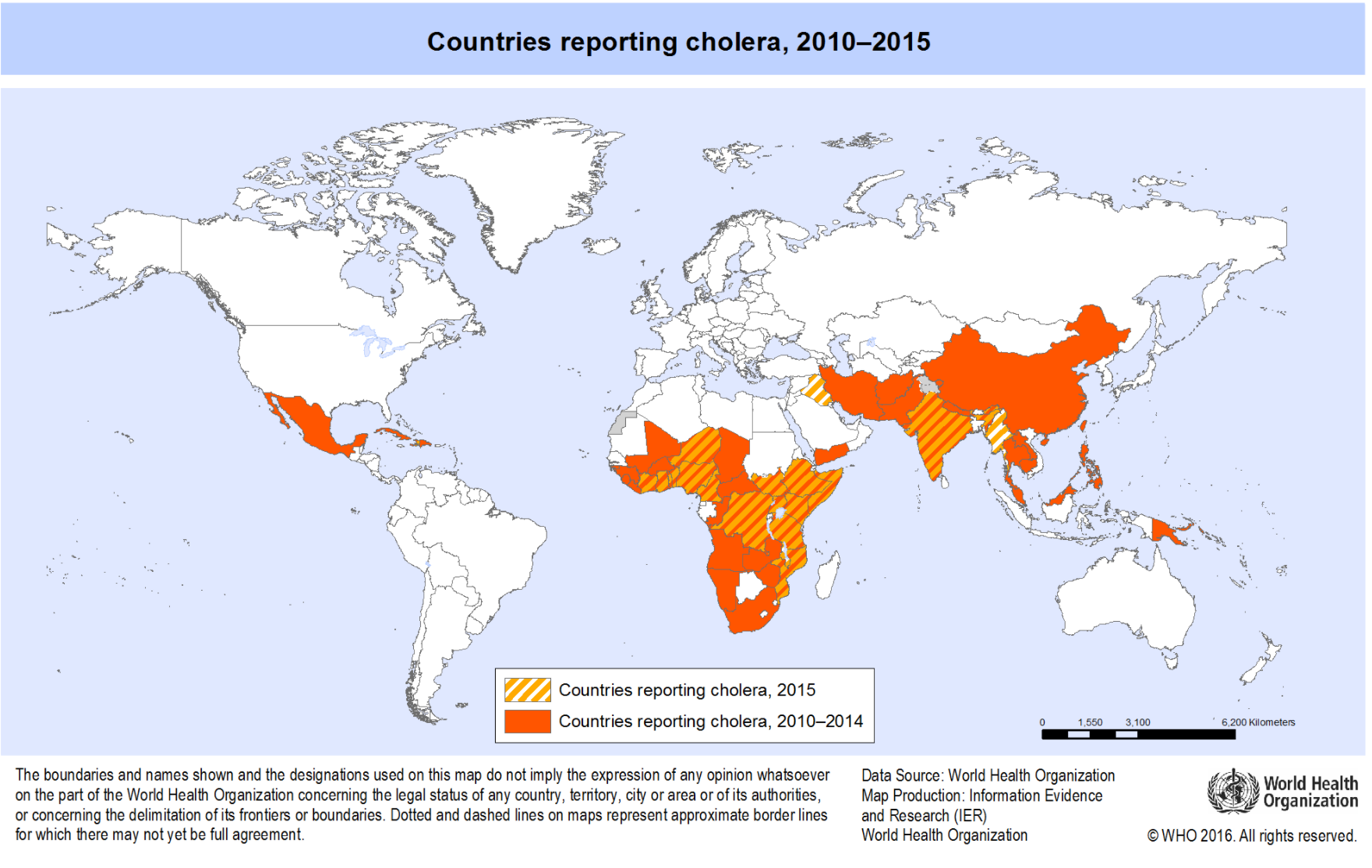Cholera epidemiology and demographics: Difference between revisions
Ahmed Younes (talk | contribs) No edit summary |
m (Bot: Removing from Primary care) |
||
| (23 intermediate revisions by 4 users not shown) | |||
| Line 1: | Line 1: | ||
__NOTOC__ | __NOTOC__ | ||
{{Cholera}} | {{Cholera}} | ||
{{CMG}}; '''Associate Editors-In-Chief:''' {{SaraM}}, {{TarekNafee}}, [[Priyamvada Singh|Priyamvada Singh, MBBS]] [mailto:psingh13579@gmail.com] | {{CMG}}; '''Associate Editors-In-Chief:''' {{SaraM}}, {{TarekNafee}}, [[Priyamvada Singh|Priyamvada Singh, MBBS]] [mailto:psingh13579@gmail.com]{{AY}} | ||
==Overview== | ==Overview== | ||
In 2015, 172,454 cases and 1,304 deaths of cholera were reported to [[WHO]] worldwide. Outbreaks continued to affect several countries. | In 2015, 172,454 cases and 1,304 deaths of cholera were reported to [[WHO]] worldwide. Outbreaks continued to affect several countries. | ||
| Line 66: | Line 66: | ||
| style="padding: 5px 5px; background: #F2F2F2;" |1817 (0.39%) | | style="padding: 5px 5px; background: #F2F2F2;" |1817 (0.39%) | ||
| style="padding: 5px 5px; background: #F2F2F2;" | | | style="padding: 5px 5px; background: #F2F2F2;" | | ||
* Cholera cases is now over 360,000 cases | * Cholera cases is now over 360,000 cases in three months only. The epidemic is declared the worst (in terms of the cases per one year) since the start of the modern recording system (highest number was in Haiti in 2011 and it recorded 340, 311 cases/year).<ref name="urlYemens cholera epidemic is worst on record: Oxfam | Yemen News | Al Jazeera">{{cite web |url=http://www.aljazeera.com/news/2017/07/yemen-cholera-epidemic-worst-record-oxfam-170721081529026.html |title=Yemen's cholera epidemic is worst on record: Oxfam | Yemen News | Al Jazeera |format= |work= |accessdate=}}</ref><ref name="urlWHO | Yemen crisis">{{cite web |url=http://www.who.int/emergencies/yemen/en/ |title=WHO | Yemen crisis |format= |work= |accessdate=}}</ref> | ||
* Oxfam estimates that the number of cases might rise above 600,000 cases making it the worst epidemic since 1949. | * Oxfam estimates that the number of cases might rise above 600,000 cases making it the worst epidemic since 1949. | ||
* Unicef states that most of the children do not have access to clean water or the proper medical care and that 17 million Yemenis do not know from where they are getting their next meal. | * Unicef states that most of the children do not have access to clean water or the proper medical care and that 17 million Yemenis do not know from where they are getting their next meal. | ||
[[Image:Cholera.PNG|center|400px|thumb|Distribution of cholera cases per 1000 people on July 17 - Source: WHO]] | [[Image:Cholera.PNG|center|400px|thumb|Distribution of cholera cases per 1000 people on July 17 - Source: http://www.who.int/en/]] | ||
|- | |||
| style="padding: 5px 5px; background: #EBEBEB;" |July 29th, 2017 | |||
| style="padding: 5px 5px; background: #F2F2F2;" |408,583 | |||
| style="padding: 5px 5px; background: #F2F2F2;" |1,885 (0.46%) | |||
| style="padding: 5px 5px; background: #F2F2F2;" | | |||
*The rate of daily infected cases is now dropping and so is the case fatality rate. | |||
*The outbreak is thought to have peaked 3 weeks ago. | |||
*Despite the slowing of the spread, the number of daily cases remains high (5,000 to 6,000 cases per day) and the outbreak remains one of the worst in the recent history. | |||
*The WHO is preparing for a massive campaign of vaccination in 2018 using 500,000 doses of oral cholera vaccine. WHO is targeting not only Yemen, but also Somalia, Kenya, Congo, Nigeria, Tanzania and South Sudan where cholera remains a concern. | |||
|- | |||
| style="padding: 5px 5px; background: #EBEBEB;" |August 5th, 2017 | |||
| style="padding: 5px 5px; background: #F2F2F2;" |453,175 | |||
| style="padding: 5px 5px; background: #F2F2F2;" |1,930 (0.42%) | |||
| style="padding: 5px 5px; background: #F2F2F2;" | | |||
* Estimates that one million children are acutely malnourished with one fifth of them has severe malnutrition.<ref name="urlYemen cholera toll rises to 1,992: WHO | Business Standard News">{{cite web |url=http://www.business-standard.com/article/news-ians/yemen-cholera-toll-rises-to-1-992-who-117073000045_1.html |title=Yemen cholera toll rises to 1,992: WHO | Business Standard News |format= |work= |accessdate=}}</ref> | |||
* Malnourished children are three times more at risk to contract the infection because of the reduced immunity. | |||
* Children below 15 years account for 44% of the new cases and 32% of the deaths.<ref name="urlWHO | Statement by UNICEF Executive Director, Anthony Lake, WFP Executive Director, David Beasley and WHO Director-General, Dr Tedros Adhanom Ghebreyesus, following their joint visit to Yemen">{{cite web |url=http://www.who.int/mediacentre/news/statements/2017/joint-visit-yemen/en/ |title=WHO | Statement by UNICEF Executive Director, Anthony Lake, WFP Executive Director, David Beasley and WHO Director-General, Dr Tedros Adhanom Ghebreyesus, following their joint visit to Yemen |format= |work= |accessdate=}}</ref> | |||
[[Image:DGIG4TSXkAEzKdv.jpg|center|500px|thumb|Source: http://www.who.int/en/]] | |||
|- | |||
| style="padding: 5px 5px; background: #EBEBEB;" |August 12th, 2017 | |||
| style="padding: 5px 5px; background: #F2F2F2;" |473,701 | |||
| style="padding: 5px 5px; background: #F2F2F2;" |1,953 (0.41%) | |||
| style="padding: 5px 5px; background: #F2F2F2;" | | |||
* The outbreak is now affecting 96% (22/23) governorates and 89% (297/333) districts.<ref name="urlWHO EMRO | Situation reports | Yemen-infocus | Yemen, WHO EMRO | Situation reports | Yemen-infocus | Yemen">{{cite web |url=http://www.emro.who.int/yem/yemeninfocus/situation-reports.html |title=WHO EMRO | Situation reports | Yemen-infocus | Yemen, WHO EMRO | Situation reports | Yemen-infocus | Yemen |format= |work= |accessdate=}}</ref> | |||
* Seventy Percent of Yemen’s 28 million population live in these affected areas.<ref name="urlYemens civil war turns country into cholera breeding ground - ABC News">{{cite web |url=http://abcnews.go.com/Health/wireStory/yemens-civil-war-turns-country-cholera-breeding-ground-49129085 |title=Yemen's civil war turns country into cholera breeding ground - ABC News |format= |work= |accessdate=}}</ref> | |||
* The overall number of suspected cases have been declining in the past five weeks, however, it has reached a plateau stage in the top 4 governorates affected. | |||
[[Image:Epidemic curve.JPG|center|500px|thumb|An epidemic curve showing the weekly number of cases during the first wave (in 2016) and the second wave (in 2017) of the outbreak - Source: http://www.who.int/en/]] | |||
[[Image:02 outcome.JPG|center|500px|thumb|The figures show the distribution of cases by age and sex. The right most figure shows the percentage of the different outcomes of suspected cases -Source: http://www.who.int/en/]] | |||
[[Image:03 Attack rate.JPG|center|500px|thumb|The map on the left shows the total number of cases in the different governorates while the map on the right shows the attack rate per 10,000 people in the same governorates - Source: http://www.who.int/en/]] | |||
|- | |||
| style="padding: 5px 5px; background: #EBEBEB;" |September 5th, 2017 | |||
| style="padding: 5px 5px; background: #F2F2F2;" |607,065<ref name="urlWHO EMRO | Situation reports | Yemen-infocus | Yemen, WHO EMRO | Situation reports | Yemen-infocus | Yemen">{{cite web |url=http://www.emro.who.int/yem/yemeninfocus/situation-reports.html |title=WHO EMRO | Situation reports | Yemen-infocus | Yemen, WHO EMRO | Situation reports | Yemen-infocus | Yemen |format= |work= |accessdate=}}</ref> | |||
| style="padding: 5px 5px; background: #F2F2F2;" |2,047 (0.34%) | |||
| style="padding: 5px 5px; background: #F2F2F2;" | | |||
* The number of cases hit the 600,000 mark. This is the double of the [[WHO]] estimates for the worst case scenario in April. | |||
* The number of cases has been falling in August but some districts report sharp increase in the number of suspected cases for the past two weeks.<ref name="urlYemens cholera epidemic hits 600,000, confounding expectations | Reuters">{{cite web |url=https://www.reuters.com/article/us-yemen-cholera/yemens-cholera-epidemic-hits-600000-confounding-expectations-idUSKCN1BG158 |title=Yemen's cholera epidemic hits 600,000, confounding expectations | Reuters |format= |work= |accessdate=}}</ref> | |||
* [[WHO]] investigates if the new rise of cases is due to cholera or due to another [[Diarrhea|diarrheal illness]]. | |||
* With the continuation of civil war, nearly 16 million Yemenis are deprived of clean water and proper sanitation. | |||
|- | |||
| style="padding: 5px 5px; background: #EBEBEB;" |September 29th, 2017 | |||
| style="padding: 5px 5px; background: #F2F2F2;" |754,373<ref name="urlWHO EMRO | Situation reports | Yemen-infocus | Yemen, WHO EMRO | Situation reports | Yemen-infocus | Yemen">{{cite web |url=http://www.emro.who.int/yem/yemeninfocus/situation-reports.html |title=WHO EMRO | Situation reports | Yemen-infocus | Yemen, WHO EMRO | Situation reports | Yemen-infocus | Yemen |format= |work= |accessdate=}}</ref> | |||
| style="padding: 5px 5px; background: #F2F2F2;" |2,119 (0.28%) | |||
| style="padding: 5px 5px; background: #F2F2F2;" | | |||
* The outbreak is declared as the worst recorded cholera outbreak after the number of suspected cases exceeded the Haiti outbreak of 2010.<ref name="urlYemen cholera outbreak set to be worst on record | The Independent">{{cite web |url=http://www.independent.co.uk/news/world/middle-east/yemen-cholera-outbreak-worst-on-record-health-middle-east-a7973726.html |title=Yemen cholera outbreak set to be worst on record | The Independent |format= |work= |accessdate=}}</ref> | |||
* There number of cases are expected to reach one million by November this year.<ref name="urlYemen cholera cases could hit 1 million by year-end: Red Cross | Reuters">{{cite web |url=http://www.reuters.com/article/us-yemen-security-redcross/yemen-cholera-cases-could-hit-1-million-by-year-end-red-cross-idUSKCN1C41WA |title=Yemen cholera cases could hit 1 million by year-end: Red Cross | Reuters |format= |work= |accessdate=}}</ref> | |||
[[Image:Cholera achievements.jpg|center|500px|thumb|Source: http://www.who.int/en/]] | |||
|} | |} | ||
| Line 95: | Line 146: | ||
The highest incidencce of cholera in the developing world occurs in the following regions:<ref name="WHO-Archive-Cholera">World Health Organization. Cholera Emergencies preparedness, response. http://www.who.int/csr/don/archive/disease/cholera/en/</ref><ref name="WHO-Archive-Cholera2">World Health Organization. Cholera Global Health Observatory | The highest incidencce of cholera in the developing world occurs in the following regions:<ref name="WHO-Archive-Cholera">World Health Organization. Cholera Emergencies preparedness, response. http://www.who.int/csr/don/archive/disease/cholera/en/</ref><ref name="WHO-Archive-Cholera2">World Health Organization. Cholera Global Health Observatory | ||
Map Gallery http://gamapserver.who.int/mapLibrary/app/searchResults.aspx</ref> | Map Gallery http://gamapserver.who.int/mapLibrary/app/searchResults.aspx</ref> | ||
*'''Africa:''' Mozambique, Liberia, Democratic Republic of Congo, Niger | *'''Africa:''' Zambia, Mozambique, Liberia, Democratic Republic of Congo, Niger | ||
*'''Asia:''' Indonesia, Bangladesh, India | *'''Asia:''' Indonesia, Bangladesh, India | ||
*'''The Americas:''' Dominican Republic, Haiti | *'''The Americas:''' Dominican Republic, Haiti | ||
*'''The Middle East:''' Yemen | *'''The Middle East:''' Yemen | ||
[[Image:Screen Shot 2016-10-06 at 9.58.35 PM.png|500px|thumb|left|Source: | [[Image:Screen Shot 2016-10-06 at 9.58.35 PM.png|500px|thumb|left|Source: http://www.who.int/en/]] | ||
[[Image:Screen Shot 2016-10-07 at 1.36.22 PM.png|500px|thumb|left|Source: | [[Image:Screen Shot 2016-10-07 at 1.36.22 PM.png|500px|thumb|left|Source: http://www.who.int/en/]] | ||
<br style="clear:both" /> | <br style="clear:both" /> | ||
| Line 117: | Line 168: | ||
== References == | == References == | ||
{{Reflist|2}} | {{Reflist|2}} | ||
{{WH}} | {{WH}} | ||
{{WS}} | {{WS}} | ||
[[Category:Gastroenterology]] | |||
[[Category:Emergency medicine]] | |||
[[Category:Disease]] | |||
[[Category:Up-To-Date]] | |||
[[Category:Infectious disease]] | |||
[[Category:Pediatrics]] | |||
Latest revision as of 20:55, 29 July 2020
|
Cholera Microchapters |
|
Diagnosis |
|---|
|
Treatment |
|
Case Studies |
|
Cholera epidemiology and demographics On the Web |
|
American Roentgen Ray Society Images of Cholera epidemiology and demographics |
|
Risk calculators and risk factors for Cholera epidemiology and demographics |
Editor-In-Chief: C. Michael Gibson, M.S., M.D. [1]; Associate Editors-In-Chief: Sara Mehrsefat, M.D. [2], Tarek Nafee, M.D. [3], Priyamvada Singh, MBBS [4]Ahmed Younes M.B.B.CH [5]
Overview
In 2015, 172,454 cases and 1,304 deaths of cholera were reported to WHO worldwide. Outbreaks continued to affect several countries. Overall, 41% of cases were reported from Africa, 37% from Asia, and 21% from the Americas.[1] In the early 1980s, mortality rates are believed to exceeded 3 million deaths a year. It is difficult to calculate exact numbers of cases, as many go unreported due to concerns that an outbreak may have a negative impact on the tourism of a country.[2] Cholera remains both epidemic and endemic in many areas of the world. Although much is known about the mechanisms behind the spread of cholera, this has not led to a full understanding of what makes cholera outbreaks happen some places but not others. Lack of adequate treatment of human feces and/or drinking water greatly facilitates the spread of cholera. Bodies of water can serve as a reservoir of the disease. Seafood shipped over long distances can also spread the disease. Cases of cholera were not observed in the Americas for most of the 20th century, thought the disease reappeared towards the end of that century and seems likely to persist.[3]
2017 Yemen outbreak
| Date | Cases (confirmed and suspected) | Deaths | More details |
| June 11th, 2017 | 101,820 | 791 (0.7%) |
|
| June 25th, 2017 | 200,000 | 1300 (0.65%) |
|
| July 2nd, 2017 | 246,000 | 1500 (0.6%) |
|
| July 10th, 2017 | 297,438 | 1706 (0.57%) |
|
| July 16th, 2017 | 326,082 | 1,743 (0.53%) |
|
| July 22nd, 2017 | 462, 545 | 1817 (0.39%) |
 |
| July 29th, 2017 | 408,583 | 1,885 (0.46%) |
|
| August 5th, 2017 | 453,175 | 1,930 (0.42%) |
 |
| August 12th, 2017 | 473,701 | 1,953 (0.41%) |
   |
| September 5th, 2017 | 607,065[11] | 2,047 (0.34%) |
|
| September 29th, 2017 | 754,373[11] | 2,119 (0.28%) |
 |
Epidemiology and Demographics
Incidence
- In 2015, 172,454 cases and 1,304 deaths of cholera were reported to WHO worldwide. Outbreaks continued to affect several countries.
- Overall, 41% of cases were reported from Africa, 37% from Asia, and 21% from the Americas.[1]
- Worldwide, cholera affects an estimated 1.4 to 4.3 million people and causes 28,000 to 142,000 deaths a year as of 2012.[16][17]
Origin and Spread
Cholera was originally endemic to the Indian subcontinent, with the Ganges River likely serving as a contamination reservoir. It spread by trade routes (both land- and sea-based) to Russia, then to Western Europe, and from Europe to North America. Cholera is no longer considered an issue in Europe and North America, due to filtering and chlorination of the water supply.
Gender
Cholera occurs equally in males and females.
Age
- In non-endemic areas, cholera occurs equally in all age groups.
- In endemic regions, children older than the age of 2 years are most commonly infected which cholera. Illness is uncommon before children reach 2 years of age, likely due to passive immunity.
Geographic Distribution
Cholera in the United States
In the United States, the occurrence of cholera is very low (0-5 cases per year) and is usually due to ingestion of contaminated food or infection during international travel. There has been a modest increase in imported cases since 1991 related to travel and ongoing epidemics.[18]
Cholera in the Developing World
The highest incidencce of cholera in the developing world occurs in the following regions:[19][20]
- Africa: Zambia, Mozambique, Liberia, Democratic Republic of Congo, Niger
- Asia: Indonesia, Bangladesh, India
- The Americas: Dominican Republic, Haiti
- The Middle East: Yemen


Case Fatality Rates
- In 2015, the case fatality rates (CFRs) for cholera ranged from 0.0% to 11.7%; globally, the overall CFR was 0.8%.[21]
- CFRs >1% were reported by 15 countries.
- Of these 15 countries, CFR >5% were reported in Myanmar and Niger.
- In Yemen, the case-fatality rate is reported to be between 4% to 5%.
- The average case fatality rate for Europe and the Americas is estimated to be around 1%.
- At the Treatment Center of the International Center for Diarrheal Disease Research in Bangladesh, less than 1% of patients with severe dehydration die.
- In Africa, a marked decline in case fatality rates has reported since 1970.
- in South America, low case fatality rates have been achieved.
References
- ↑ 1.0 1.1 World Health Organization. Global Health Observatory (GHO) data. http://www.who.int/gho/epidemic_diseases/cholera/en/ Accessed on October 5th, 2016
- ↑ Sack DA, Sack RB, Chaignat CL (2006). "Getting serious about cholera". N. Engl. J. Med. 355 (7): 649–51. doi:10.1056/NEJMp068144. PMID 16914700. Unknown parameter
|month=ignored (help) - ↑ Blake, PA (1993). "Epidemiology of cholera in the Americas". Gastroenterology clinics of North America. 22 (3): 639–60. PMID 7691740.
- ↑ 4.0 4.1 "WHO | Number of suspected cholera cases reaches 100 000 in Yemen".
- ↑ "Yemen cholera cases pass the 100,000 mark: WHO | Reuters".
- ↑ 6.0 6.1 "WHO | Statement from UNICEF Executive Director Anthony Lake and WHO Director-General Margaret Chan on the cholera outbreak in Yemen as suspected cases exceed 200,000".
- ↑ "Yemen's cholera epidemic is worst on record: Oxfam | Yemen News | Al Jazeera".
- ↑ "WHO | Yemen crisis".
- ↑ "Yemen cholera toll rises to 1,992: WHO | Business Standard News".
- ↑ "WHO | Statement by UNICEF Executive Director, Anthony Lake, WFP Executive Director, David Beasley and WHO Director-General, Dr Tedros Adhanom Ghebreyesus, following their joint visit to Yemen".
- ↑ 11.0 11.1 11.2 "WHO EMRO | Situation reports | Yemen-infocus | Yemen, WHO EMRO | Situation reports | Yemen-infocus | Yemen".
- ↑ "Yemen's civil war turns country into cholera breeding ground - ABC News".
- ↑ "Yemen's cholera epidemic hits 600,000, confounding expectations | Reuters".
- ↑ "Yemen cholera outbreak set to be worst on record | The Independent".
- ↑ "Yemen cholera cases could hit 1 million by year-end: Red Cross | Reuters".
- ↑ World Health Organization. Cholera. (2016) http://www.who.int/mediacentre/factsheets/fs107/en/ Accessed on October 5th,2016
- ↑ Ali M, Lopez AL, You YA, et al. The global burden of cholera. Bulletin World Health Organization 2012; 90: 209–18A.
- ↑ Centers for Disease Control and prevention. Sources of Infection & Risk Factors. http://www.cdc.gov/cholera/infection-sources.html Accessed on October 5th, 2016
- ↑ World Health Organization. Cholera Emergencies preparedness, response. http://www.who.int/csr/don/archive/disease/cholera/en/
- ↑ World Health Organization. Cholera Global Health Observatory Map Gallery http://gamapserver.who.int/mapLibrary/app/searchResults.aspx
- ↑ World Heath Organization. Global Health Observatory (GHO) 2016. dathttp://www.who.int/gho/epidemic_diseases/cholera/case_fatality_rate_text/en